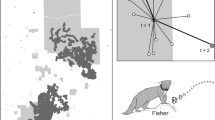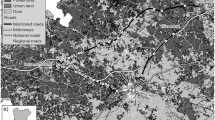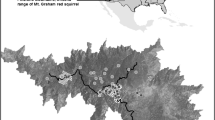Abstract
Context
Understanding connectivity patterns in relation to habitat fragmentation is essential to landscape management. However, connectivity is often judged from expert opinion or species occurrence patterns, with very few studies considering the actual movements of individuals. Path selection functions provide a promising tool to infer functional connectivity from animal movement data, but its practical application remains scanty.
Objectives
We aimed to describe functional connectivity patterns in a forest carnivore using path-level analysis, and to explore how connectivity is affected by land cover patterns and road networks.
Methods
We radiotracked 22 common genets in a mixed forest-agricultural landscape of southern Portugal. We developed path selection functions discriminating between observed and random paths in relation to landscape variables. These functions were used together with land cover information to map conductance surfaces.
Results
Genets moved preferentially within forest patches and close to riparian habitats. Functional connectivity declined with increasing road density, but increased with the proximity of culverts, viaducts and bridges. Functional connectivity was favoured by large forest patches, and by the presence of riparian areas providing corridors within open agricultural land. Roads reduced connectivity by dissecting forest patches, but had less effect on riparian corridors due to the presence of crossing structures.
Conclusions
Genet movements were jointly affected by the spatial distribution of suitable habitats, and the presence of a road network dissecting such habitats and creating obstacles in areas otherwise permeable to animal movement. Overall, the study showed the value of path-level analysis to assess functional connectivity patterns in human-modified landscapes.


Similar content being viewed by others
References
Ascensão F, Grilo C, LaPoint S, Tracey J, Clevenger AP, Santos-Reis M (2014) Inter-individual variability of stone marten behavioral responses to a highway. PLoS One 9:e103544
Ascensão F, Mira A (2007) Factors affecting culvert use by vertebrates along two stretches of road in Southern Portugal. Ecol Res 22:57–66
Balestrieri A, Remonti L, Ruiz-González A, Zenato M, Gazzola A, Vergara M, Dettori EE, Saino N, Capelli E, Gómez-Moliner BJ, Guidali F, Prigioni C (2015) Distribution and habitat use by pine marten Martes martes in a riparian corridor crossing intensively cultivated lowlands. Ecol Res 30:153–162
Barbosa AM, Brown JA, Jiménez-Valverde A, Real R (2014) modEvA: model evaluation and analysis. R package, version 1.1. http://modeva.r-forge.r-project.org/
Barton K (2013) MuMIn: Multi-model inference. R package version 1.9.0. http://CRAN.R-project.org/package=MuMIn
Borthagaray AI, Barreneche JM, Abades S, Arim M (2014) Modularity along organism dispersal gradients challenges a prevailing view of abrupt transitions in animal landscape perception. Ecography 37:564–571
Burnham KP, Anderson DR (2002) Model selection and multimodel inference: a practical information-theoretic approach. Springer, New York
Carvalho F, Carvalho R, Mira A, Beja P (2014) The use of tree hollows by a Mediterranean forest carnivore. For Ecol Manag 315:54–62
Coulon A, Morellet N, Goulard M, Cargnelutti B, Angibault JM, Hewison AJM (2008) Inferring the effects of landscape structure on roe deer (Capreolus capreolus) movements using a step selection function. Landscape Ecol 23:603–614
Crooks KR, Burdett CL, Theobald DM, Rondinini C, Boitani L (2011) Global patterns of fragmentation and connectivity of mammalian carnivore habitat. Phil Trans R Soc B 366:2642–2651
Crooks KR, Sanjayan M (2006) Connectivity conservation. Conservation biology, vol 14. Cambridge University Press, Cambridge
Crouzeilles R, Prevedello JA, Figueiredo MZL, Lorini ML, Grelle CEV (2014) The effects of the number, size and isolation of patches along a gradient of native vegetation cover: how can we increment habitat availability? Landscape Ecol 29:479–489
Cushman AS, Lewis JS, Landguth E (2013) Evaluating the intersection of a regional wildlife connectivity network with highways. Move Ecol 1:1–12
Cushman AS, Lewis JS, Landguth E (2014) Why did the bear cross the road? Comparing the performance of multiple resistance surfaces and connectivity modeling methods. Diversity 6:844–854
Cushman SA (2010) Animal movement data: GPS telemetry, autocorrelation and the need for path-level analysis. In: Cushman SA, Huettman F (eds) Spatial complexity, informatics and wildlife conservation. Springer, Tokyo, pp 131–149
Cushman SA, Compton BW, McGarigal K (2010) Habitat fragmentation effects depend on complex interactions between population size and dispersal ability: modeling influences of roads, agriculture and residential development across a range of life-history characteristics. In: Cushman SA, Huettman F (eds) Spatial complexity, informatics and wildlife conservation. Springer, Tokyo, pp 369–385
Cushman SA, Lewis JS (2010) Movement behavior explains genetic differentiation in American black bears. Landscape Ecol 25:1613–1625
Cushman SA, Raphael MG, Ruggiero LF, Shirk AS, Wasserman TN, O’Doherty EC (2011) Limiting factors and landscape connectivity: the American marten in the Rocky Mountains. Landscape Ecol 26:1137–1149
Dickson BG, Jenness JS, Beier P (2005) Influence of vegetation, topography, and roads on cougar movement in southern California. J Wild Manag 69:264–276
Dickson BG, Roemer GW, McRae BH, Rundall JM (2013) Models of regional habitat quality and connectivity for pumas (Puma concolor) in the southwestern United States. PLoS One 8:e81898
Dormann CF, Elith J, Bacher S, Buchmann C, Carl G, Carré G, Marquéz JR, Gruber B, Lafourcade B, Leitão PJ, Münkemüller T (2013) Collinearity: a review of methods to deal with it and a simulation study evaluating their performance. Ecography 36:27–46
Duchesne T, Fortin D, Courbin N (2010) Mixed conditional logistic regression for habitat selection studies. J Anim Ecol 79:548–555
Elliot NB, Cushman SA, Macdonald DW, Loveridge AJ (2014) The devil is in the dispersers: predictions of landscape connectivity change with demography. J Appl Ecol 51:1169–1178
Fahrig L, Baudry J, Brotons L, Burel FG, Crist TO, Fuller RJ, Sirami C, Siriwardena GM, Martin J-L (2011) Functional landscape heterogeneity and animal biodiversity in agricultural landscapes. Ecol Lett 14:101–112
Fahrig L, Rytwinski T (2009) Effects of roads on animal abundance: an empirical review and synthesis. Ecol Soc 14:21
Ferreras P, Rodríguez A, Palomares F, Delibes M (2010) Iberian lynx: the uncertain future of a critically endangered cat. In: Macdonald DW, Loveridge JA (eds) Biology and conservation of wild felids. Oxford University Press, Oxford, pp 507–520
Fielding AH, Bell JF (1997) A review of methods for the assessment of prediction errors in conservation presence/absence models. Environ Conserv 24:38–49
Foley JA, DeFries R, Asner GP, Barford C, Bonan G, Carpenter SR, Chapin FS, Coe MT, Daily GC, Gibbs HK, Helkowski JH (2005) Global consequences of land use. Science 309:570–574
Fu W, Liu S, Degloria SD, Dong S, Beazley R (2010) Characterizing the “fragmentation–barrier” effect of road networks on landscape connectivity: a case study in Xishuangbanna, Southwest China. Landsc Urban Plan 95:122–129
Galantinho A, Mira A (2009) The influence of human, livestock, and ecological features on the occurrence of genet (Genetta genetta): a case study on Mediterranean farmland. Ecol Res 24:671–685
Grilo C, Bissonette JA, Santos-Reis M (2009) Spatial-temporal patterns in Mediterranean carnivore road casualties: consequences for mitigation. Biol Conserv 142:301–313
Grilo C, Sousa J, Ascensão F, Matos H, Leitão I, Pinheiro P, Costa M, Bernardo J, Reto D, Lourenço R, Santos-Reis M (2012) Individual spatial responses towards roads: implications for mortality risk. PLoS One 7:e43811
Guiomar N, Batista T, Fernandes JP, Souto CC (2009) Corine Land Cover Nível 5. Contribuição para a Carta de Uso do Solo em Portugal Continental. AMDE Edt. Évora
Gurrutxaga M, Saura S (2014) Prioritizing highway defragmentation locations for restoring landscape connectivity. Environ Conserv 41:157–164
Harju SM, Olson CV, Dzialak MR, Mudd JP, Winstead JB (2013) A flexible approach for assessing functional landscape connectivity, with application to greater sage-grouse (Centrocercus urophasianus). PLoS One 8:e82271
Hartmann SA, Steyer K, Kraus RHS, Segelbacher G, Nowak C (2013) Potential barriers to gene flow in the endangered European wildcat (Felis silvestris). Conserv Genet 14:413–426
Hijmans RJ (2012) Cross-validation of species distribution models: removing spatial sorting bias and calibration with a null model. Ecology 93:679–688
IPMA (Instituo Português do Mar e da Atmosfera) (2012) Normais climatológicas (1971–2000). http://www.ipma.pt. Accessed on 26 Apr 2012
Kadoya T (2009) Assessing functional connectivity using empirical data. Popul Ecol 51:5–15
Klar N, Herrmann M, Henning-Hahn M, Pott-Dörfer B, Hofer H, Kramer-Schadt S (2012) Between ecological theory and planning practice: (re-)connecting forest patches for the wildcat in Lower Saxony, Germany. Landsc Urban Plan 105:376–378
Klar N, Herrmann M, Kramer-Schadt S (2009) Effects and mitigation of road impacts on individual movement behavior of wildcats. J Wild Manag 73:631–638
LaPoint S, Balkenhol N, Hale J, Sadler J, van Der Ree R (2015) Ecological connectivity research in urban areas. Funct Ecol 29:868–878
LaPoint S, Gallery P, Wikelski M, Kays R (2013) Animal behavior, cost-based corridor models, and real corridors. Landscape Ecol 28:1615–1630
Legendre P, Legendre L (1998) Numerical ecology, 2nd edn. Elsevier, Amsterdam
Levin N, McAlpine C, Phinn S, Price B, Pullar D, Kavanagh RP, Law BS (2009) Mapping forest patches and scattered trees from SPOT images and testing their ecological importance for woodland birds in a fragmented agricultural landscape. Int J Remote Sens 30:3147–3169
Lindenmayer DB, Fischer J (2006) Habitat fragmentation and landscape change: an ecological and conservation synthesis. Island Press, Washington D.C.
Liu C, Berry PM, Dawson TP, Pearson RG (2005) Selecting thresholds of occurrence in the prediction of species distributions. Ecography 28:385–393
McGarigal K, Cushman SA, Ene E (2012) FRAGSTATS v4: spatial pattern analysis program for categorical and continuous Maps. University of Massachusetts, Amherst. http://www.umass.edu/landeco/research/fragstats/fragstats.html. Accessed on 07 Apr 2015
Mergey M, Helder R, Roeder JJ (2011) Effect of forest fragmentation on space-use patterns in the European pine marten (Martes martes). J Mammal 92:328–335
Millspaugh JJ, Marzluff JM (2001) Radio tracking and animal populations. Academic Press, Washington D.C
Nogués S, Cabarga-Verona A (2014) Modelling land use changes for landscape connectivity: the role of plantation forestry and highways. J Nat Conserv 22:504–515
Palomares F, Delibes M (1994) Spatio-temporal ecology and behaviour of European genets in southwestern Spain. J Mammal 75:714–724
Pe’er G, Kramer-Schadt S (2008) Incorporating the perceptual range of animals into connectivity models. Ecol Model 213:73–85
Pereira M, Rodríguez A (2010) Conservation value of linear woody remnants for two forest carnivores in a Mediterranean agricultural landscape. J Appl Ecol 47:611–620
Polak T, Rhodes JR, Jones D, Possingham HP (2014) Optimal planning for mitigating the impacts of roads on wildlife. J Appl Ecol 51:726–734
Quantum GIS Development Team (2014) Quantum GIS Geographic Information System. Open Source Geospatial Foundation Project
R Development Core Team (2013) R: a language and environment for statistical computing. R Foundation for Statistical Computing, Vienna
Reding DM, Cushman SA, Gosselink TE, Clark WR (2013) Linking movement behavior and fine-scale genetic structure to model landscape connectivity for bobcats (Lynx rufus). Landscape Ecol 28:471–486
Richard Y, Armstrong DP (2010) Cost distance modelling of landscape connectivity and gap-crossing ability using radio-tracking data. J Appl Ecol 47:603–610
Riley SPD, Pollinger JP, Sauvajot RM, York EC, Bromley C, Fuller TK, Wayne RK (2006) A southern California freeway is a physical and social barrier to gene flow in carnivores. Mol Ecol 15:1733–1741
Roever CL, van Arde RJ, Leggett K (2013) Functional connectivity within conservation networks: delineating corridors for African elephants. Biol Conserv 157:128–135
Rondinini C, Boitani L (2002) Habitat use by beech martens in a fragmented landscape. Ecography 25:257–264
Rosalino LM, Ferreira D, Leitão I, Santos-Reis M (2011) Usage patterns of Mediterranean agro-forest habitat components by wood mice Apodemus sylvaticus. Mamm Biol 76:268–273
Rosalino LM, Santos-Reis M (2002) Feeding habits of the common genet Genetta genetta (Carnivora: Viverridae) in a semi-natural landscape of central Portugal. Mammalia 66:195–206
Rudnick DA, Ryan SJ, Beier P, Cushman SA, Dieffenbach F, Epps CW, Gerber LR, Hartter J, Jenness JS, Kintsch J, Merenlender AM, Perkl RM, Preziosi V, Trombulak SC (2012) The role of landscape connectivity in planning and implementing conservation and restoration priorities. Issues Ecol 16:1–20
Santos MJ, Santos-Reis M (2010) Stone marten (Martes foina) habitat in a Mediterranean ecosystem: effects of scale, sex, and interspecific interactions. Eur J Wild Res 56:275–286
Santos SM, Lourenço R, Mira A, Beja P (2013) Relative effects of road risk, habitat suitability, and connectivity on wildlife roadkills: the case of tawny owls (Strix aluco). PLoS One 8:e79967
Saura S, Bodin Ö, Fortin M-J (2014) Stepping stones are crucial for species´ long-distance dispersal and range expansion through habitat networks. J Appl Ecol 51:171–182
Saura S, Pascual-Hortal L (2007) A new habitat availability index to integrate connectivity in landscape conservation planning: comparison with existing indices and application to a case study. Landsc Urban Plan 83:91–103
Saura S, Torné J (2009) Conefor Sensinode 2.2: a software package for quantifying the importance of habitat patches for landscape connectivity. Environ Model Softw 24:135–139
Schielzeth H (2010) Simple means to improve the interpretability of regression coefficients. Method Ecol Evol 1:103–113
Serronha AM, Mateus ARA, Eaton F, Santos-Reis M, Grilo C (2013) Towards effective culvert design: monitoring seasonal use and behavior by Mediterranean mesocarnivores. Environ Monit Assess 185:6235–6246
Silva CC, Lourenço R, Godinho S, Gomes E, Sabino-Marques H, Medinas D, Neves V, Silva C, Rabaça JE, Mira A (2012) Major roads have a negative impact on the tawny owl Strix aluco and the little owl Athene noctua populations. Acta Ornithol 47:47–54
Taylor PD, Fahrig L, Henein K, Merriam G (1993) Connectivity is a vital element of landscape structure. Oikos 68:571–573
Therneau T (2012) Coxme: mixed effects cox models. R package version 2.2–3. https://cran.r-project.org/web/packages/coxme/coxme.pdf
Tjur T (2009) Coefficients of determination in logistic regression models—a new proposal: the coefficient of discrimination. A Stat 63:366–372
Villalva P, Reto D, Santos-Reis M, Revilla E, Grilo C (2013) Do dry ledges reduce the barrier effect of roads? Ecol Eng 57:143–148
Virgós E, Llorente M, Cortésá Y (1999) Geographical variation in genet (Genetta genetta L.) diet: a literature review. Mammal Rev 29:117–126
Walpole AA, Bowman J, Murray DL, Wilson PJ (2012) Functional connectivity of lynx at their southern range periphery in Ontario, Canada. Landscape Ecol 27:761–773
Zeller KA, McGarigal K, Cushman SA, Beier P, Vickers TW, Boyce WM (2015) Using step and path selection functions for estimating resistance to movement: pumas as a case study. Landscape Ecol. doi:10.1007/s10980-015-0301-6
Zeller KA, McGarigal K, Whiteley AR (2012) Estimating landscape resistance to movement: a review. Landscape Ecol 27:777–797
Acknowledgments
This study was funded by the Fundação para a Ciência e Tecnologia through grant SFRH/BD/66393/2009 to FC. Logistic support was given by the Conservation Biology Unit and Institute of Mediterranean Agricultural and Environmental Sciences, both from the University of Évora. Ana Galantinho, Pedro Costa and the MOVE project team collaborated in field work; Giovanni Manghi helped in GIS processing, and José Potes (Veterinarian Hospital, University of Évora) supervised the handling of genets. We thank the careful review of the manuscript by Santiago Saura and two anonymous reviewers. Authorization for capturing, handling and tracking genets was provided by the Instituto para a Conservação da Natureza e da Biodiversidade.
Author information
Authors and Affiliations
Corresponding author
Electronic supplementary material
Below is the link to the electronic supplementary material.
Rights and permissions
About this article
Cite this article
Carvalho, F., Carvalho, R., Mira, A. et al. Assessing landscape functional connectivity in a forest carnivore using path selection functions. Landscape Ecol 31, 1021–1036 (2016). https://doi.org/10.1007/s10980-015-0326-x
Received:
Accepted:
Published:
Issue Date:
DOI: https://doi.org/10.1007/s10980-015-0326-x




